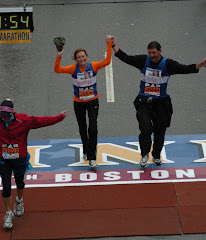
I heard this quote years ago but I'm just realizing how prophetic it really is. In my past life (back when I was a youngster in my 30's), training for a marathon consisted of lacing up a new pair of shoes and getting out for a regular run 6 days a week. Little or no stretching, little concern for weather, no plan for water or gatorade, no concern for the size of the hills on the route, or even a thought about injuries. Just me, the road and my thoughts. Ahhh, the good old days.
.
Today, I wouldn't think about doing a run over 5 miles without water and a MP3 player. If the weather looks bad I'll retreat to the treadmill at the gym (bad weather defined as too cold, too windy, too wet, too dark, too many leaves on the ground, too many beers last night...). If the hill is too big (as defined by taking more than 10 seconds to get to the top), find another route...preferably downhill (Boston is actually a net downhill marathon...although you would have a hard time convincing me while I'm halfway up Heartbreak Hill).
.
You can imagine my surprise when I started training for this year's marathon much like I had in the past and everything did not work the way it use to. First to go was the endurance. Lesson One: the body needs more rest between runs than in the past and stretching is now a critical part of keeping the leg muscles from contorting into knots that leave me walking like Frankenstein. The first to object was my left calf which would seize up when running up hill. In my infinite wisdom and denial I proceeded to ignore the warnings and instead altered my stride to favor the calf. That resulted in a problem with the right hamstring that required I shorten my stride to keep from pulling the muscle, particularly on downhills. With uphills and downhills out, a limp on the left leg, short hopping stride on the right I was pretty much restricted to running only on relatively flat terrain, around my neighborhood. Next to go was the right knee whenever I would get over 11 miles. As with any machine that is out of balance, the parts that are doing things that they are not made to do soon wear out. In this case it was my IT Band. In my blind wish to keep training I ignored all this until a neighbor asked me if I had seen the poor deformed man that was limping back and forth around the neighborhood. Lesson Two: when hurt, seek help right away...And see Lesson One.
.
In an attempt to make up for ignoring the timely application of the above lessons, and with only three weeks to go before the marathon, I implemented a crash course in body maintenance. I started with a quick trip to the doctors to get a cortisone shot in my right knee. This was followed by several days of rest, ice baths (yupp...you sit in a tub of ice...it's a modern day version of medieval torture tactics), and stretching (you can teach an old dog new tricks...if he is desperate enough). Next up was a sports massage. I could do a whole blog on sports massages but I think the best way to explain the experience is to relay the response from the massage therapist when I asked him if his wife appreciated that she could have a professional massage whenever she wanted. He responded," When I first started, I use to do massages at my house. After hearing the screams from the first few clients she has never let me do a massage on her."
.
So, with less than three weeks until the marathon my body is tuned up and I'm ready to start training...again. At this point I'm pretty sure I will be at the starting line with Heather. I'm just not sure about the finish line.
.
One thing I do know....if doing my first marathon had involved all of this effort, I'm not sure I ever would have made it to the starting line. I have new found respect for anyone running their first marathon at my age.



